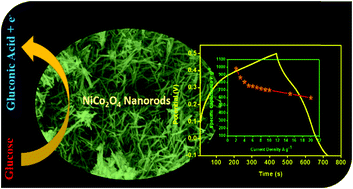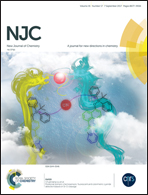Multifunctional porous NiCo2O4 nanorods: sensitive enzymeless glucose detection and supercapacitor properties with impedance spectroscopic investigations†
Abstract
We report the multipurpose nature of NiCo2O4 nanorods fabricated by a facile two-step method for high-performance glucose sensors and supercapacitors. The nanorods that were obtained were investigated by various physicochemical characterization techniques, which revealed their polycrystallinity, suitable microstructure, high porosity and thermal stability. The nanorods that were synthesized were assembled on a glassy carbon electrode (GCE) with a Nafion support via layer-by-layer assembly (Nafion/NCO/GCE or NNCOGCE). The NNCOGCE that was fabricated was employed as a working electrode for two separate applications, namely, a glucose sensor and a supercapacitor. The NNCOGCE selectively detected glucose in a short amperometric response time (3 s), with a wide dynamic linear range (0.001–0.88 mM), a notable detection limit (63 nM) and high sensitivity (4.710 μA μM−1 cm−2). Moreover, the NNCOGCE exhibited high specific capacitance (980 F g−1 at a current density of 2 A g−1) and excellent rate performance (retention of 71.42% up to 10 A g−1) with a long cycle life (retention of 92% up to 1000 cycles). Finally, the NNCOGCE was studied by electrochemical impedance spectroscopy (EIS) to investigate its charge transfer characteristics for both glucose sensor and supercapacitor applications, and the results were correlated with its amperometric sensing ability, as well as its supercapacitor performance.



 Please wait while we load your content...
Please wait while we load your content...